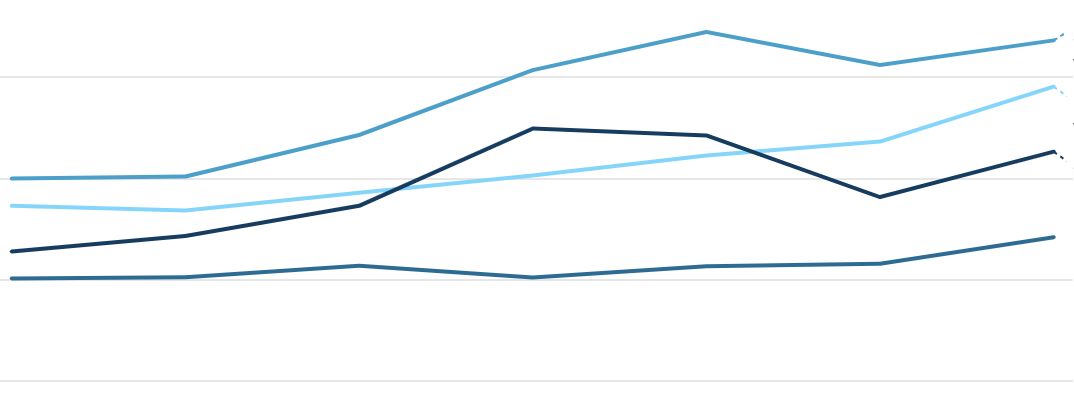Ben is joined by Professor Matthew Shugart from UC Davis to discuss how the electoral system influences the party system. We discuss the effective number of parties measure, and the seat product model, which uses the size of the parliamentary assembly and the district magnitude to predict the shape of the party system in each country.
- The SPM is explained most simply in this journal article.
- Or you can check out Votes From Seats, which explains it in more detail.
As discussed on the podcast, this chart shows the effective number of parties in Australian federal elections since 2004.
This podcast is supported by the Tally Room’s supporters on Patreon. If you find this podcast worthwhile please consider giving your support.
You can subscribe to this podcast using this RSS feed in your podcast app of choice, but should also be able to find this podcast by searching for “the Tally Room”. If you like the show please considering rating and reviewing us on iTunes.




Interesting conversation Ben, the anomalous outlier US being discussed at the end left me with a few thoughts. The things that are not included into the model are those real but hard to quantify & measure factors that reinforce an established political system. One such example is media-coverage which informs voters what the viable candidates are in the electoral contests. Another obvious but hard to quantify example is the influential power of the elected parties (I will not go into this one in this comment). There are a variety of other factors and agents that can entrench an established political order too.
Perhaps the US is anomalously low given its basic inputs because of this variety of factors and agents that entrench their established political order. Let’s consider the aforementioned example of media-coverage. The consolidated national media landscape which defines the US political contests and focuses on the Presidential contest emphasises the two-party system and reinforces the narrative that a vote for another party outside of the Democrats or Republicans is a “waste” or even worse a “spoiler”.
This led me to think about the Australian context. Shugart raised the point towards the end that he believes Australia based on its inputs, arrives at an ESP fairly close to what it “should” have as part of a typical first-past-the-post voting system. The issue is that it really does seem like our preferential voting system does have a tangible & observable effect on the viability of the non-major parties. State and Federal seat contests where a party like the Greens come from 2nd or 3rd place and win the 2CP are an obvious tangible outcome that only emerges in the preferential voting system and cannot happen in FPTP. I also find it hard to assume that a plurality of voters would en-masse collectively change their vote AND produced the exact same outcome under FPTP either.
At a more abstract level, because of this added “preferential dynamic”, including the order of exclusion, the chance of a realised outcome deviating from the expected outcome is inherently more uncertain and involves greater ranges of probabilities. Using monte-carlo style modelling (a bit like the AE Forecasts model), this would deliver tangibly more non-expected (non-two-party) outcomes over X amount of political contests than FPTP voting.
This raises the point again about the entrenchment of an established political order by various factors and agents. The example before, media-coverage, is also applicable to the Australian context. Australia, similarly to the US also has a relatively consolidated media landscape. Media-coverage of elections in Australia also emphasise the two-party contest between Coalition and Labor. Despite the lack of a Presidential voting-system in Australia and elections representing many contests being conducted across the Australia, the election-coverage in Australia still constructs and presents a presidential narrative centered around the political leaders of the two major parties. This presidential-narrative is largely borrowed from the political-coverage in the USA and reinforces the idea of a “two-party” system in Australia.
So I pose the question… if our two-party system wasn’t as entrenched or influenced by media-coverage which reinforces a Two-Party system, would our electoral contests produce a higher ESP? An ESP which clearly deviates from the other international political contests which uses FPTP voting? It seems from my perspective that preferential voting would produce a greater variety of political parties in principal, and this dynamic is being offset in the Australian context by an entrenched & established two-party political order (like the USA). This offset has allowed us to arrive by coincidence at a typical FPTP ESP.
I also see this two-party order in Australia now beginning to fracture, especially as other political forces like “teals” and Greens and even ONP & UAP receive more attention as part of election media-coverage. But there are so many other factors to point to regarding this fracturing in the Australian context. Regardless its fascinating, I applaud Shugart for laying down some foundations here for psephologists to work with RE: political fracturing.
Not sure where I read it, but I vaguely recall one explanation for the US having such a strong two party system is that their preselection – rather, primary system, makes the electoral system closer to a two round system.
And the different “parties” are just instead, just factions within either democratic or Republican Party.
Well, as I type this, I realise France provides a strong counter of two round but multi party – but the primary system does help explain why crossing the floor and voting against the party is much more common in the US. What’s the party going to do, not preselect you? The primary voters do that. (Which then allows individual congress members to break with party leadership more often)
Yeah I definitely think the primary system is a factor.
Comments are closed.